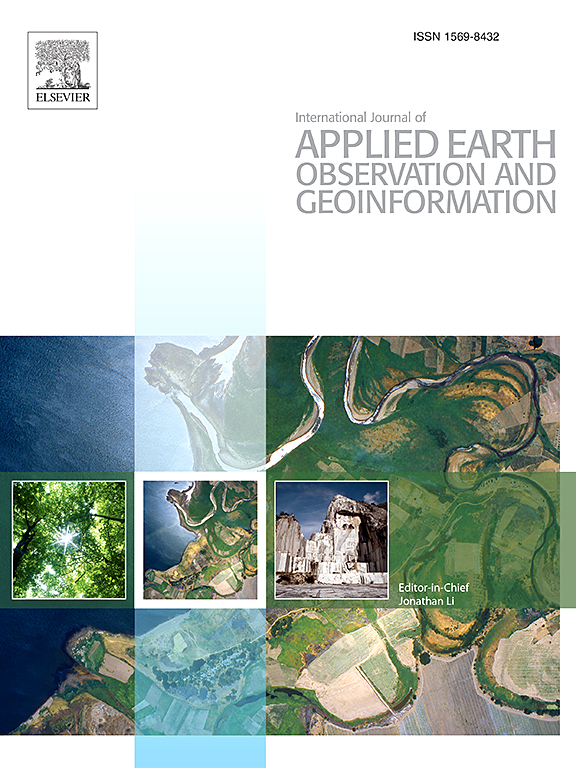Detection and monitoring of Melampsora spp. Damage in multiclonal poplar plantations coupling biophysical models and Sentinel-2 time series
IF 7.6
Q1 REMOTE SENSING
International journal of applied earth observation and geoinformation : ITC journal
Pub Date : 2025-06-11
DOI:10.1016/j.jag.2025.104663
引用次数: 0
Abstract
Climate change is dramatically shifting the distribution and prevalence of pests and diseases, posing significant threats to global forest ecosystems. Poplar plantations, particularly multiclonal ones, are highly vulnerable to pathogen-driven diseases such as leaf rust caused by Melampsora spp. In this study, we developed three machine learning (ML) detection models (DMs) for identifying rust-affected poplar trees coupling Sentinel-2 time series and the PROSAIL radiative transfer model. For each DM, three ML algorithms (support vector machines, random forests, and neural networks) were trained using in situ leaf rust inspections as reference data, and the following inputs: (i) inverted plant traits retrieved from the PROSAIL model, (ii) key spectral indices derived from Sentinel-2 time series, and (iii) a combination of both plant traits and indices from Sentinel-2 images. The best-performing DM, which combined plant traits and spectral indices, achieved an overall accuracy of 89.5 % (Kappa = 0.78) across three tested ML algorithms. Relative importance analysis highlighted chlorophylls (21 %), carotenoids (16 %), and leaf water content (11 %) as the most critical variables for rust detection. This study shows the potential of combining biophysical models with Sentinel-2 imagery for precise and scalable rust detection in multiclonal poplar plantations. Our approach also highlights how key plant traits, such as chlorophyll, carotenoids, and leaf water content, vary across poplar clones, offering valuable insights for forest management and conservation strategies in the context of climate change. The framework we propose is adaptable and transferable to different regions and conditions, enhancing disease monitoring and forest health management. Its robustness is further supported by external validation using the ANGERS spectral database, confirming the physiological relevance of the retrieved traits.
基于生物物理模型和Sentinel-2时间序列的多克隆杨树林黑僵菌危害检测与监测
气候变化正在极大地改变病虫害的分布和流行,对全球森林生态系统构成重大威胁。摘要基于Sentinel-2时间序列和PROSAIL辐射转移模型,建立了3种机器学习(ML)检测模型,用于鉴定受锈病影响的杨树,特别是多克隆杨树对Melampsora spp引起的叶锈病非常敏感。对于每个DM,使用原位叶锈病检测作为参考数据,对三种ML算法(支持向量机、随机森林和神经网络)进行训练,并使用以下输入:(i)从PROSAIL模型中检索到的倒置植物性状,(ii)从Sentinel-2时间序列中提取的关键光谱指数,以及(iii)从Sentinel-2图像中提取的植物性状和指数的组合。在三种被测试的ML算法中,表现最好的DM结合了植物性状和光谱指数,总体准确率达到89.5% (Kappa = 0.78)。相对重要性分析显示叶绿素(21%)、类胡萝卜素(16%)和叶片含水量(11%)是检测锈病的最关键变量。该研究显示了将生物物理模型与Sentinel-2图像相结合,在多克隆杨树人工林中进行精确和可扩展的锈病检测的潜力。我们的方法还强调了关键植物性状,如叶绿素、类胡萝卜素和叶片含水量在杨树无性系之间的差异,为气候变化背景下的森林管理和保护策略提供了有价值的见解。我们提出的框架具有适应性和可转移性,适用于不同地区和条件,可加强疾病监测和森林健康管理。使用ANGERS光谱数据库的外部验证进一步支持了其鲁棒性,确认了检索特征的生理相关性。
本文章由计算机程序翻译,如有差异,请以英文原文为准。
求助全文
约1分钟内获得全文
求助全文
来源期刊

International journal of applied earth observation and geoinformation : ITC journal
Global and Planetary Change, Management, Monitoring, Policy and Law, Earth-Surface Processes, Computers in Earth Sciences
CiteScore
12.00
自引率
0.00%
发文量
0
审稿时长
77 days
期刊介绍:
The International Journal of Applied Earth Observation and Geoinformation publishes original papers that utilize earth observation data for natural resource and environmental inventory and management. These data primarily originate from remote sensing platforms, including satellites and aircraft, supplemented by surface and subsurface measurements. Addressing natural resources such as forests, agricultural land, soils, and water, as well as environmental concerns like biodiversity, land degradation, and hazards, the journal explores conceptual and data-driven approaches. It covers geoinformation themes like capturing, databasing, visualization, interpretation, data quality, and spatial uncertainty.
 求助内容:
求助内容: 应助结果提醒方式:
应助结果提醒方式:


